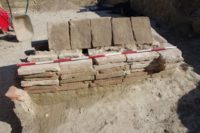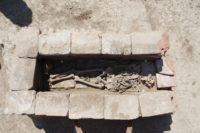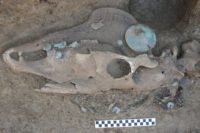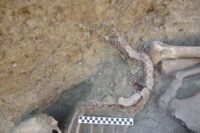Two rare Avar graves have been unearthed by archaeologists in the city  cemetery of Vinkovci, eastern Croatia. This is the first Avar grave ever found in Vinkovci. The former Roman city of Cibalae in southeastern Pannonia was under Avar control in the 7th and 8th centuries, but until now, none of their graves had been discovered.
cemetery of Vinkovci, eastern Croatia. This is the first Avar grave ever found in Vinkovci. The former Roman city of Cibalae in southeastern Pannonia was under Avar control in the 7th and 8th centuries, but until now, none of their graves had been discovered.
Fittingly enough, the ancient graves were discovered by workers expanding the Roman Catholic Cemetery of Vinkovci to make room for more burial plots. When they bumped up against a grave made of old tiles, they stopped work and called in archaeologists from the city museum. They unearthed a tile cist with a tile tent roof containing skeletal remains of an adult. When inclement weather and even more inclement pathogens struck Croatia, all archaeological investigations were suspended, but because the tomb had already been partially exposed and was in danger from the elements and from looters, the excavation was given a dispensation to continue.
Graves made from recycled roof tiles, bricks and slabs were fairly common in the late Roman period. They came in a variety of forms — simple cut graves with tile floors, cists with roofs of curved tiles placed convex-side up, curved tiles tilted against each other to cover the body, tiles used to make floors, walls, placed at head and feet and against each other in a tent-shaped roof. They have been found in Italy as well as France, Greece and other parts of the Empire. They generally date to late antiquity
 Because the tile grave in Vinkovci is an elaborate version with complete walls, end pieces and gabled roof made of Roman brick and marble slabs taken from what had once been a luxury property, archaeologists first thought this was a late Roman burial. A few pieces of bronze found inside the tomb dated it stylistically to the the turn of the 7th to the 8th century, the Avar period. That means the invaders, having destroyed many Roman towns and driven their residents to flee west, used the ruins of their architecture to copy a Roman burial. That’s rarely found so late, and indicates there may have been some continuity of population in the area from late antiquity through the migration period and into the early Middle Ages.
Because the tile grave in Vinkovci is an elaborate version with complete walls, end pieces and gabled roof made of Roman brick and marble slabs taken from what had once been a luxury property, archaeologists first thought this was a late Roman burial. A few pieces of bronze found inside the tomb dated it stylistically to the the turn of the 7th to the 8th century, the Avar period. That means the invaders, having destroyed many Roman towns and driven their residents to flee west, used the ruins of their architecture to copy a Roman burial. That’s rarely found so late, and indicates there may have been some continuity of population in the area from late antiquity through the migration period and into the early Middle Ages.
 The second is a cut grave containing the remains of a man and a horse complete with copper bridle ornaments. The grave had been looted in antiquity, but the thieves only stripped the warrior’s body of its adornments. The horse buried with him still had its finery, including an iron bit, iron stirrups and iron saddle braces, the first Avar saddle remains ever found in Croatia. The bronze ornaments on the harness include bronze rosettes, gilded circles and six fittings in the shape of a boar’s head.
The second is a cut grave containing the remains of a man and a horse complete with copper bridle ornaments. The grave had been looted in antiquity, but the thieves only stripped the warrior’s body of its adornments. The horse buried with him still had its finery, including an iron bit, iron stirrups and iron saddle braces, the first Avar saddle remains ever found in Croatia. The bronze ornaments on the harness include bronze rosettes, gilded circles and six fittings in the shape of a boar’s head.
 This is a very rich Avar warrior burial, of a type found in important military cities that were part of a defensive ring along the southern Avar border in the turbulent 8th century. Its presence in Vinkovci opens up the possibility that it too may have been for some time one of the defensive strongholds on the southern border.
This is a very rich Avar warrior burial, of a type found in important military cities that were part of a defensive ring along the southern Avar border in the turbulent 8th century. Its presence in Vinkovci opens up the possibility that it too may have been for some time one of the defensive strongholds on the southern border.
There are at least five more graves at the site and archaeologists will continue to excavate. They will remain on site to supervise the expansion of the city cemetery in case any more finds are revealed.